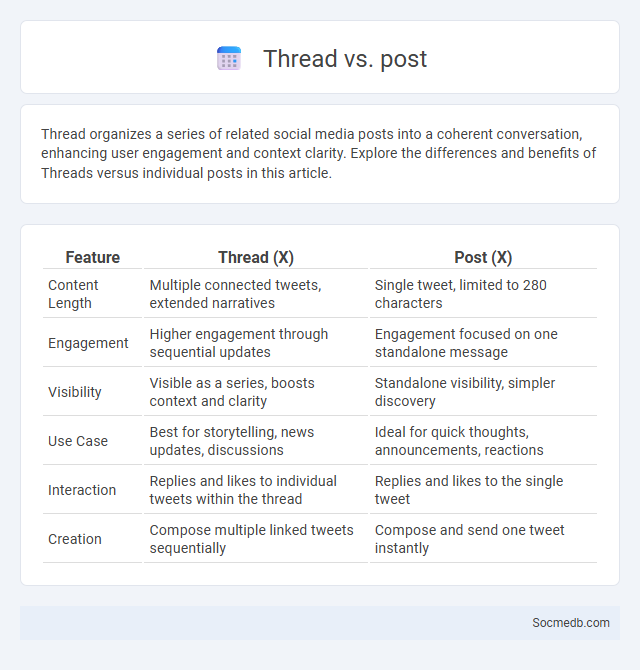
Photo illustration: Thread vs Post
Thread organizes a series of related social media posts into a coherent conversation, enhancing user engagement and context clarity. Explore the differences and benefits of Threads versus individual posts in this article.
Table of Comparison
| Feature | Thread (X) | Post (X) |
|---|---|---|
| Content Length | Multiple connected tweets, extended narratives | Single tweet, limited to 280 characters |
| Engagement | Higher engagement through sequential updates | Engagement focused on one standalone message |
| Visibility | Visible as a series, boosts context and clarity | Standalone visibility, simpler discovery |
| Use Case | Best for storytelling, news updates, discussions | Ideal for quick thoughts, announcements, reactions |
| Interaction | Replies and likes to individual tweets within the thread | Replies and likes to the single tweet |
| Creation | Compose multiple linked tweets sequentially | Compose and send one tweet instantly |
Understanding Threads: Definition and Purpose
Threads on social media are organized sequences of posts or comments that create a continuous flow of conversation around a particular topic or event. They help you follow discussions more easily by grouping related content together, improving engagement and clarity. Understanding threads enhances your ability to navigate complex dialogues and participate meaningfully in online communities.
What is a Post? Key Differences from Threads
A social media post is a single piece of content shared by a user, often consisting of text, images, videos, or links designed to engage followers. In contrast, a thread is a series of connected posts that create a continuous narrative or discussion on a specific topic, enabling deeper context or extended storytelling. Posts offer standalone messages, while threads facilitate ongoing conversations and detailed exploration of subjects.
Thread vs Post: A Direct Comparison
Threads organize conversations by grouping related posts, enhancing user engagement through structured dialogue and context preservation. Individual posts serve as standalone content pieces that deliver concise messages or updates, optimized for quick consumption and broader reach. The key difference lies in threads fostering in-depth discussions, while posts prioritize immediate visibility and simplicity.
Thread vs Comment: Clarifying the Confusion
Threads organize social media conversations by grouping related comments under a single post, allowing Your followers to follow and engage in extended discussions more easily. Comments are individual responses that appear beneath a post or thread, often making it harder to track the flow of dialogue if not structured within a thread. Understanding this distinction enhances Your ability to navigate social media interactions and improve communication clarity.
How Threads Structure Online Discussions
Threads structure online discussions by organizing messages into clear, chronological sequences that facilitate easy tracking of conversations and responses. This hierarchical format allows you to follow multiple subtopics within a single discussion seamlessly, enhancing engagement and clarity. Well-structured threads improve information retrieval and ensure that relevant points remain connected, boosting the overall quality of social media interactions.
Best Practices for Posting in Threads
Maximize engagement on social media by crafting concise, relevant posts in threads that maintain a clear narrative flow. Use targeted keywords and hashtags to enhance visibility, while encouraging interaction through open-ended questions or calls to action in your content. Prioritize consistency in posting schedule to build your audience's trust and foster long-term community growth.
Common Misconceptions: Threads, Posts, and Comments
Many users mistakenly believe that threads, posts, and comments serve identical roles in social media interaction, when in fact threads represent a series of connected posts that facilitate in-depth conversations. Posts function as individual content units shared by users, while comments are responses within these posts, fostering dialogue and engagement. Understanding these distinctions improves content organization and enhances user engagement strategies on platforms like Facebook, Twitter, and Instagram.
The Role of Threads in Online Communities
Threads serve as essential structures for organizing discussions within online communities, allowing users to follow specific topics and contribute coherently. They facilitate focused interactions, enhance user engagement, and support the development of subcultures by grouping related content. By enabling nested conversations, threads improve information retrieval and foster a sense of belonging among community members.
Choosing Between Starting a Thread or Posting a Comment
Choosing between starting a thread or posting a comment on social media depends on the depth of your message and the engagement you seek. Starting a thread is ideal for sharing detailed information, sparking discussions, or exploring complex topics, while posting a comment works best for quick feedback, questions, or support on an existing conversation. Your decision influences the visibility and interaction your content will receive on platforms like Twitter, Reddit, and Facebook.
Future Trends: Evolution of Threads and Posts
The future of social media will see threads and posts evolve with enhanced interactivity and multimedia integration, enabling richer user engagement. Artificial intelligence-driven content curation will personalize threads, reducing information overload and increasing relevancy for users. Emerging technologies like augmented reality and blockchain will transform traditional posts into immersive experiences while ensuring content authenticity and security.
 socmedb.com
socmedb.com